
Hey there! Welcome back to the photo-tour of my trip to Japan. In case you’re just joining us, it took place between the 3rd and 15th of September, 2007. You can see all of the previous entries by clicking: https://comics212.net/category/japan/.
…so right after we get back from our sojourn to the Kansai area (Osaka/Kyoto/Nara/Himeji), we decide to head out to Shinjuku. In retrospect this was a huge mistake, because Shinjuku is a massive area of town with the JR Train Station right in the center, and really, it’s the hub of everything. To the west of the station is Tokyo City Hall and the financial district, to the east is Kabuki-cho, the naughty area of town. To the south though is an awesome building that combines a Tokyu Hands (see our Ikebukuro entry from much earlier for more on Tokyu Hands), a Takashimaya department store, and a massive 8-floor bookstore, Kinokuniya Books. Kinokuniya is probably best known in the west as the best place to get all of the cool untranslated manga, and they’ve got outlets all over the country. In Japan though, it’s just the largest bookstore there is, with the Shinjuku flagship store weighing in with 8 massive floors, including an entire floor more-or-less dedicated to English-language books.
We got to Shinjuku late as it was, and then spent 2 hours at Kinokuniya (when honestly, we could’ve spent a whole day). We should never have tried to do this on so little time. What were we thinking? Next trip we’re going to explore more of Shinjuku, but we also might just plan for a good 6 hours at this bookstore.

We started out the trip, as usual, in quaint Saitama. This is the view opposite the train station, which I thought was lovely in its way. This is what’s known as “the golden hour.”
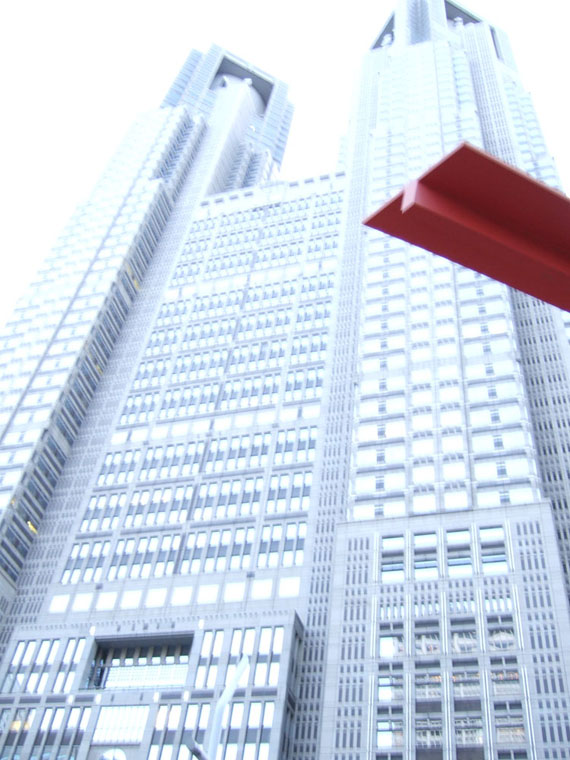
We got to Shinjuku just as the sun was setting, and everything we read and everyone we talked to insisted that we needed to see the Tokyo City Hall, and so off we went. Two massive towers, connected and then extending separately. It’s a weird building.
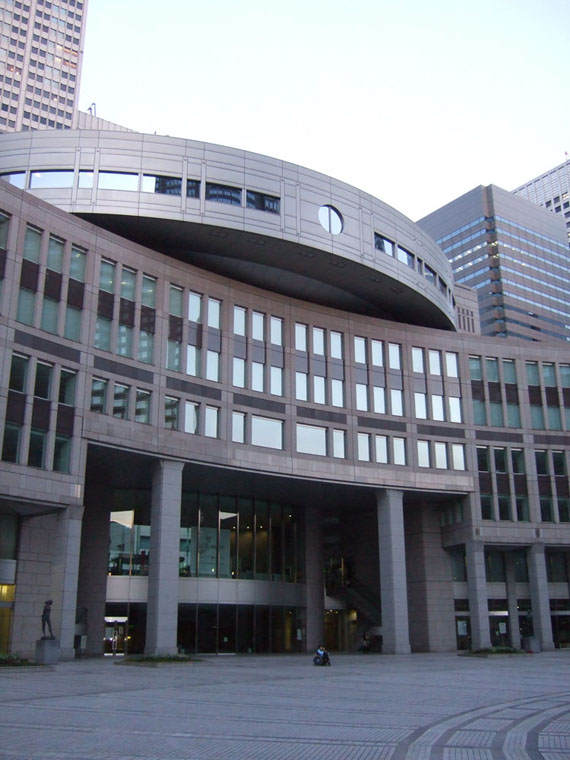
I guess weird isn’t descriptive enough… It’s more like the scale is off. The whole thing looks like its built for giants. It’s beautiful, but it implies that everyone walking into it is kind of small and pathetic in comparison. So much for caring, compassionate gov’t.
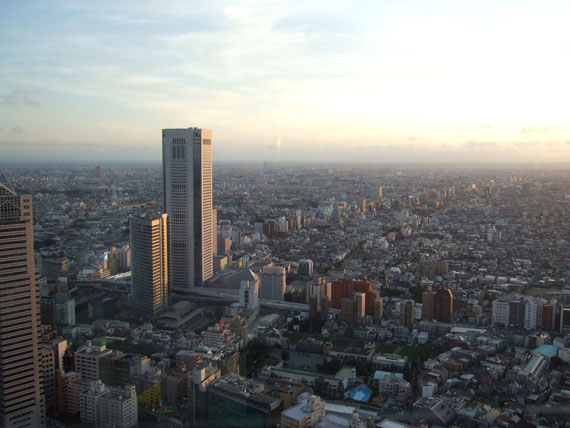
The view from the top is lovely though. Notice the way everything is built, with mostly 7-9 floor low-rises, and larger buildings built up along major streets where the real estate is more valuable. Intersections of the most valuable real estate get skyscrapers. Sort of a cost/benefit analysis laid bare. “Sure, the higher we build the buildings, the greater the change they’ll get destroyed when the next quake hits. But it’s worth so much money we can afford to build the buildings quake proof and charge everyone triple!”
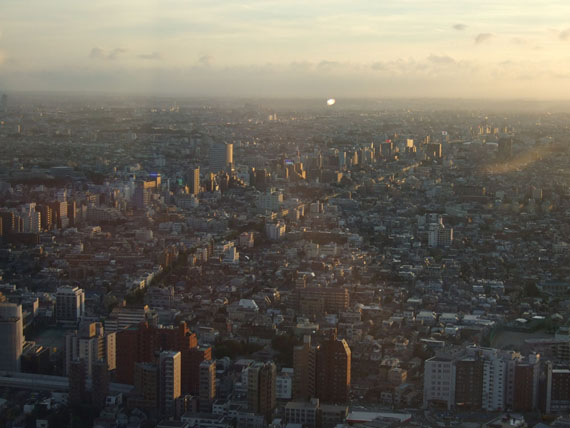


Long way up… or down.
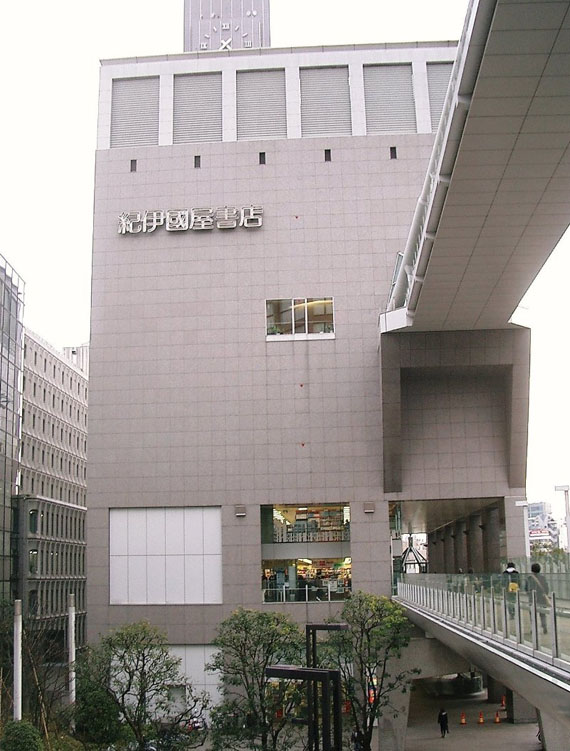
Okay, unfortunately I had to cheat a little. The photo above is from Wikimedia commons, taken by the user “Ons”. My photo of the exterior of the building turned out absolutely terrible.
So as I mentioned, Kinokuniya is an 8-floor bookstore in Shinjuku, which is both daunting and awesome. You can’t exactly get lost in there, but you can certainly lose yourself. Because of our time constraints, we decided to only visit the fifth floor English-language books section. When I visit people’s houses I love looking at their bookshelves, and I sort of treated my visit here the same way. I didn’t assume I’d buy anything, but I did want to see how English-language books, and possibly comics, were faring in Japan.
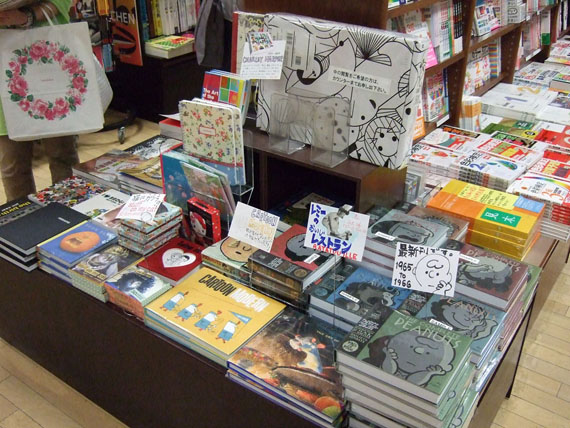
The first display I triped over was this, adjacent to the artbooks! It’s all of the Fantagraphics editions of Peanuts! Awesome! Resting alongside the fabulous Cartoon Modern book, the Chip Kidd Peanuts biography, and… a Love Is… collection. Heh. Ah well. Congratulations to Fantagraphics for being the best-represented North American comics publisher I encountered in Japan: two stores.
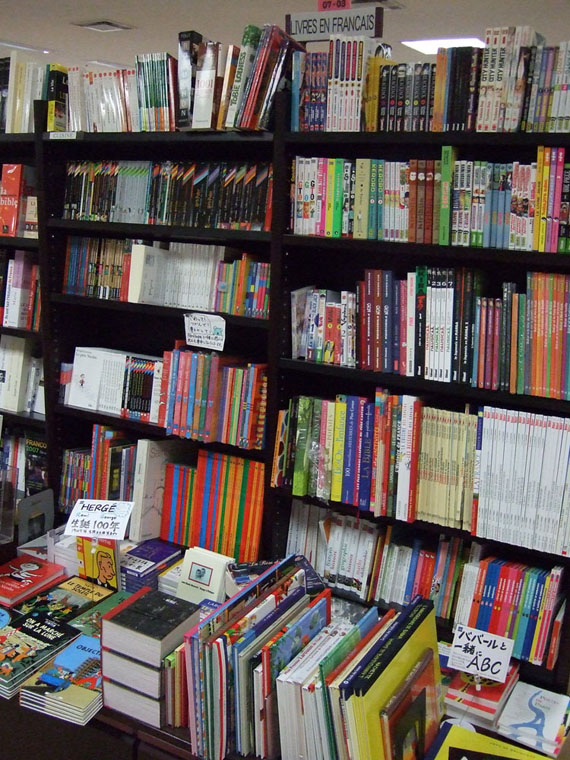
We actually found the French-language section next, and France was nicely represented through BD, children’s books, novels, business books, and more. Near-complete collections of Tintin and Asterix were present, and right after I took this photo a little French boy ran up and grabbed a Tintin volume, which was great to see. It’s nice to know that were I an ex-pat living in Japan, I could still buy beautiful French albums that I had no hope of reading.

 Then I found the English-language graphic novels shelf. Sadly, it was only one bay, but when I really looked at it I realized what an impressive selection of books it was! They had a great collection of art comics on the one hand, and that week’s new releases in TPB format from DC on the other (I think it was the second or third 52 collection).
Then I found the English-language graphic novels shelf. Sadly, it was only one bay, but when I really looked at it I realized what an impressive selection of books it was! They had a great collection of art comics on the one hand, and that week’s new releases in TPB format from DC on the other (I think it was the second or third 52 collection).
I was so impressed with this selection of books that I actually took a couple of larger photos of the shelf just to show you why I was impressed… and, I’ll admit, to give some of the less-represented publishers a little kick in the butt to maybe get their work better represented. You can click on that smaller image to the right and see the full-size bookshelf.

I guess I shouldn’t have been too surprised about this, but it genuinely caught me off guard: they had a ton of English language manga. At least 6 bays of it, including the big Viz feature display there (everyone loves Death Note). Tokyopop and Viz were about equally represented, with material from Dark Horse, Del Rey, and at least a few other smaller publishers making appearances as well.
But no OEL.
Seriously, I didn’t see one book that could be considered “OEL Manga” or “World Manga” anywhere in the store, and that included the manga AND English-language sections. Kinda strange, eh?
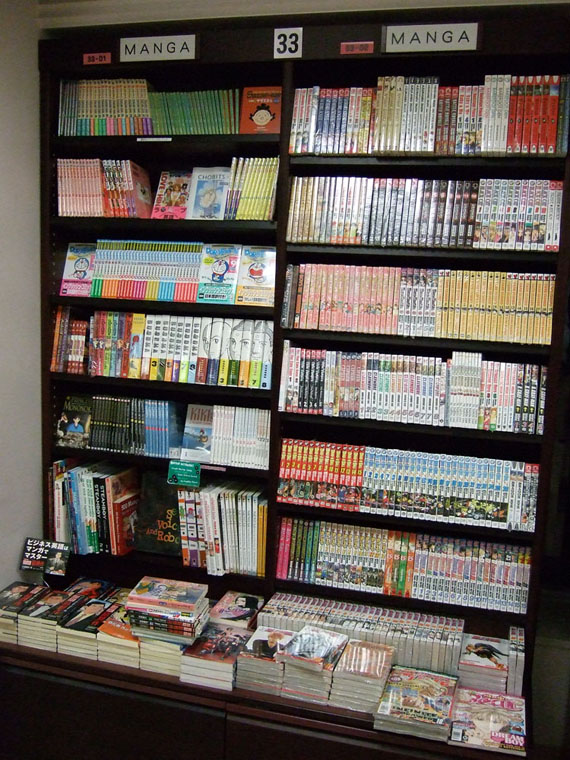
Here’s the first two bays of manga, with the beginning of the alphabet and over-sized material. Props to Shonen Jump and Shojo Beat for making appearances, and kudos to whomever decided to give a full-facing to the excellent Sexy Voice and Robo. Oh, and you can clearly see Vertical’s edition of Tezuka’s Buddha there too, props to them on a striking cover design!
If you check the upper-left shelf, you’ll see some relatively unfamiliar manga. These are in fact English language, they’re the “learn English through manga” releases from Kodansha, which includes the kick-ass Salaryman manga Division Chief!, classic kids adventure series Doraemon, and gentle domestic comedy Sazae-san, all otherwise untranslated and unavailable to English readers. The translations are a little bit stiff, but the production is beautiful.
This is the point at which I broke down and started making a pile of things to buy (you can see the stack at the bottom of the picture). I got representative samples of every manga series translated into English but otherwise unavailable in North America, and in hindsight I probably should’ve bought two or three times as much. It’s not like Doraemon is going to drop in English any time soon. If and when I make it back, I know what I’m stocking up on to sell at the store…
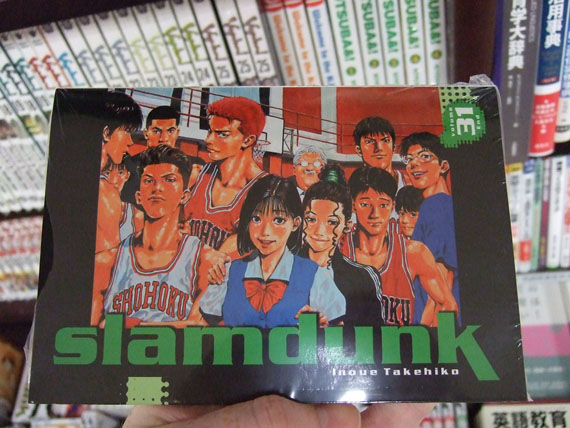
I also found this kinda/sorta strange book, which is an English language edition of SLAM DUNK by Takehiko Inoue. The complete series was translated, apparently for exclusive distribution in Asia. I couldn’t pass it up and so I bought the last volume, just so I could spoil the ending for myself :).

Other areas of note included the fiction section, which included lots of translated novels by Viz (Be With You, Brave Story, Kamikaze Girls, Train Man) and Vertical (Boy, Crimson Labyrinth).
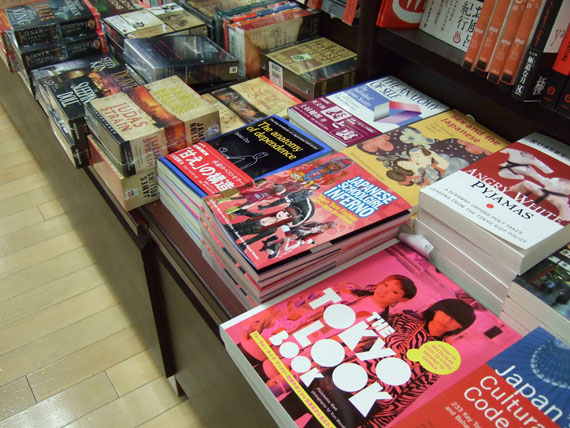
I kinda wanted to drop a bunch of money on books about Japan in English from a store in Japan, but I decided to skip it. I did take a photo of Patrick Macias‘ then-recently released Japanese School Girl Inferno because I thought the idea of a guide for westerners to the history of Japanese schoolgirl fashion being sold in Japan was ingenious.
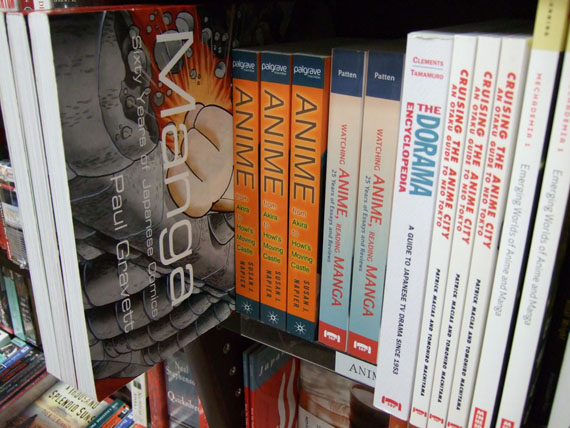
On that note, Macias’ Cruising The Anime City was an invaluable edition to my trip, and I’d recommend anyone taking a trip to Japan read this thing front to back and then back again. The cultural insight into the Japanese otaku mindset and history will help you navigate your way through Japan better than many of the included maps. Oh, and I also wanted to give a shout-out to my friend Paul Gravett, I’m sure he’d be chuffed to know his lovely book Manga: Sixty Years of Japanese Comics made its way to Japanese bookstores.
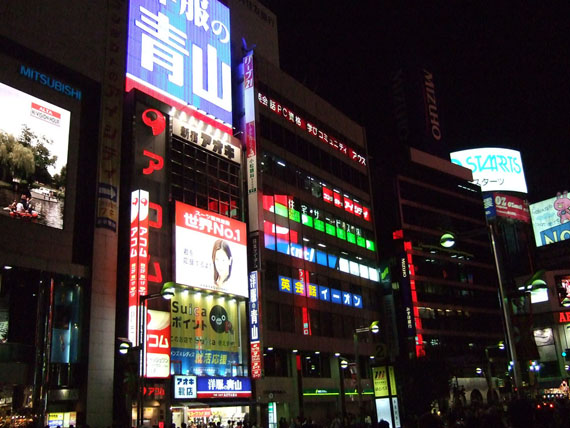
And then we disappeared into the night.
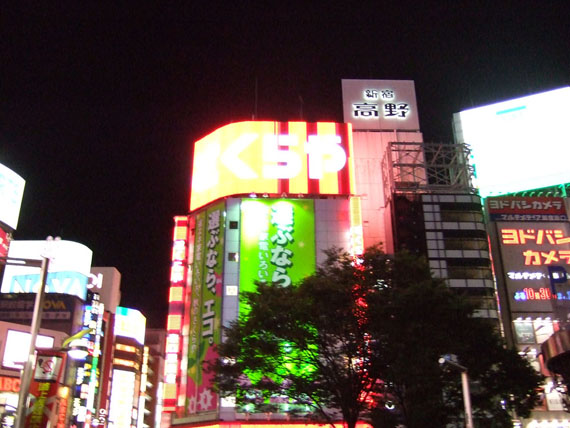
So, here’s my closing thought: A Japanese bookstore in Japan has a better selection and diversity of product for English-language graphic novels, including manga, bd, superheroes, artcomix, strip collections, etc., than 90% of comic stores in North America; if Kinokuniya can develop a market for that material then North American stores could too, and there’s nothing stopping them.
– Christopher
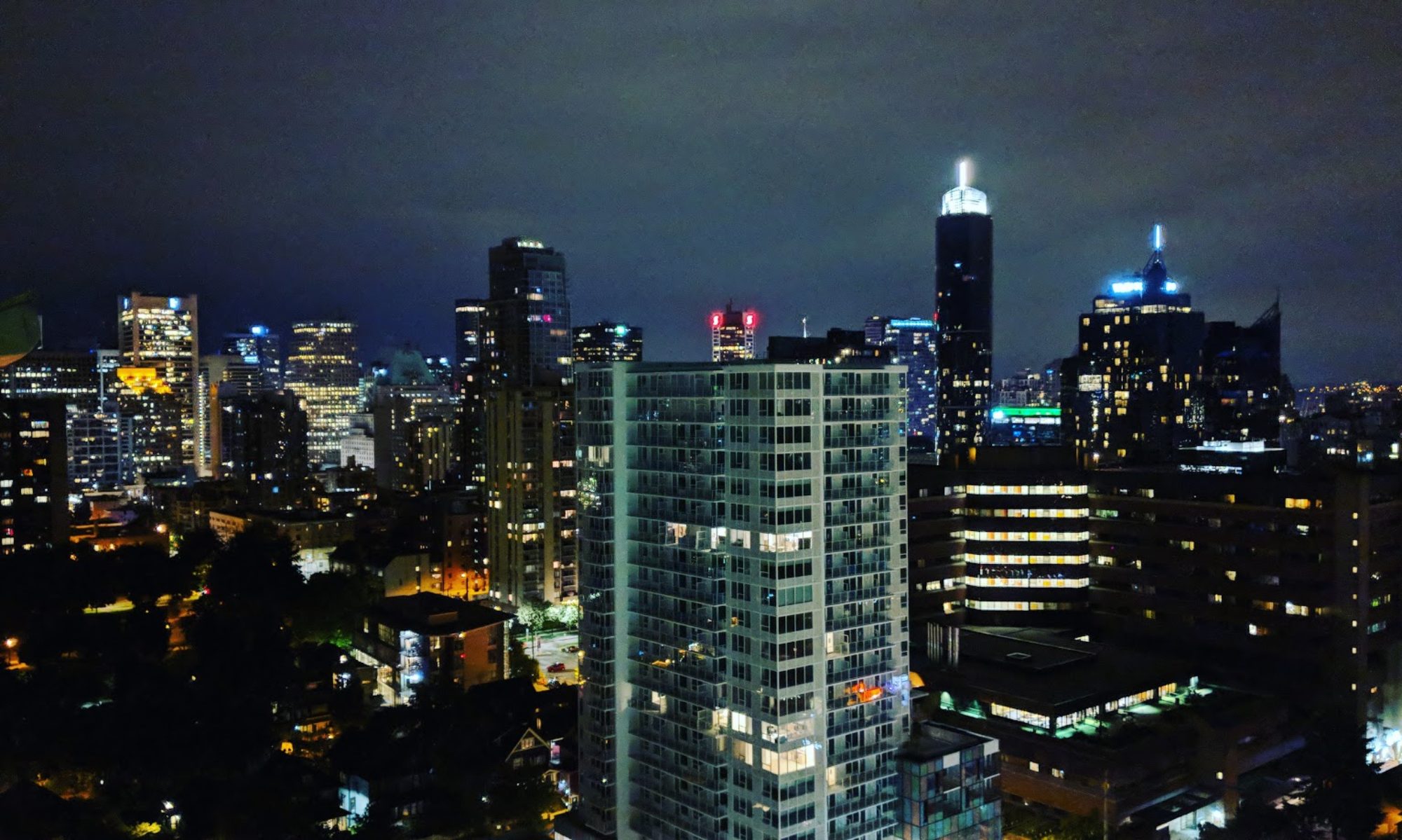

I always enjoy these photo tours!
I see “Cruising the Anime City” is copyright 2004. Things are changing so fast, is the information still up to date?
I love that store! I go there and to Tower Records to skim through their comic selection. I’ve lived in Japan for over a year and am so glad to have found these two stores.
I’m curious to see what you found at Nakano Broadway. I actually went there for the first time last month and am obsessed with it! Particularly Tacoche, which had some strange stuff, and then this one giant manga store near it that stocked a bit of older, weirder stuff. I want to find more older, weirder stuff…
I hope I can go back soon…
Peter S: Thanks very much. I think Cruising The Anime City is a wonderful companion to your Japanese trip. The book felt very up-to-date when we were using it, and even when certain retailers would have gone out of business or areas would have changed, I still think it was valuable. Much better than a couple of my other non-nerd guidebooks. Worth buying.
Jose- I love it too! I didn’t hit any of the Tokyo Tower Records while I was in Japan, but I did visit the Tatsuya/Tsutaya (can’t remember the spelling) store across from Shibuya station in Shibuya, and it was FUCKING AWESOME. Go right now, it was the best stocked, best merchandised comics section I saw in Japan.
Taco Che was fun but cramped, and my lack of Japanese skills and my inability to know what I actually wanted hindered my shopping there. In the end I bought some older Junko Mizuno manga, a Kazuo Umezu tribute book, and some fan comics, but I liked the Mandarake used store a lot more. I’ll spend more time there next time.
Thanks for commenting, guys!
– Chris
Chris-
That Slumdunk translation you picked up is from Singapore and is distributed through New Zealand and Australia along with several other manga titles (such as Fruits Baskets) through Madman Entertainment- though I don’t know if they are a superior translation to the Tokyopop or Viz editions, they certainly are cheaper.
I often see those Kodansha dual-language books second-hand here in New Zealand, which makes me wonder if they had a wider release here compared to America.